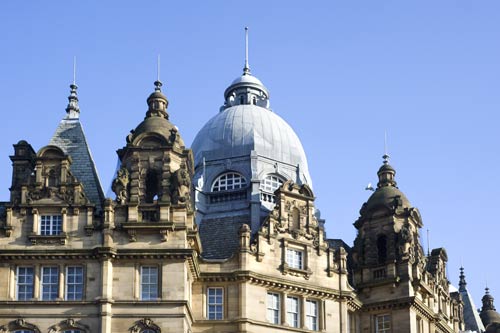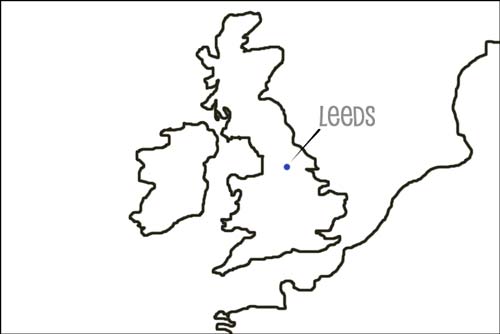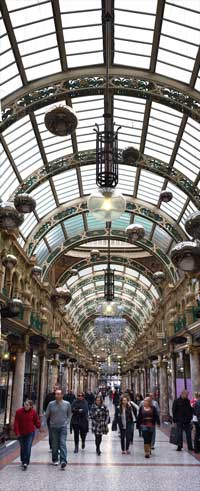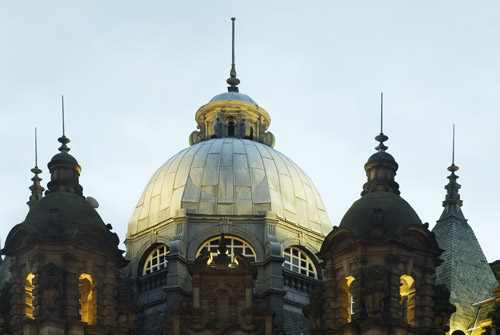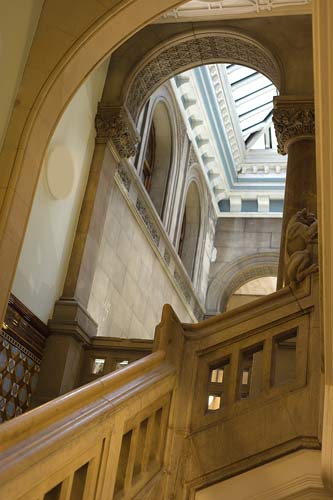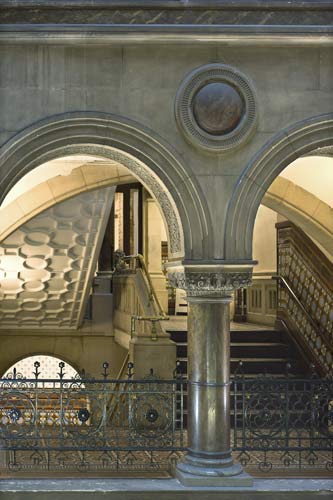A Very Brief Introduction
Leeds is an industrial city – or it was before the destruction of British industry,
Only a fool or a liar would say that Leeds is a beautiful city, but there are some beautiful buildings in it.
So starting first by way of an introduction to some of the poorer areas of Leeds, this article is an homage to some of those fine buildings.
Leeds On The Map
The city of Leeds is in the north of England on the River Aire. The soft water that flowed down over the millstone grit of the Yorkshire Dales made it perfect for treating wool. That is how Leeds grew in size and wealth off the back of the industrialization of the woollen industry.
Later on, Leeds grew larger still from the heavy engineering works that spread out along the river.
Where The Workers Lived
Outside the city center, there were streets and streets of grimy back-to-back houses built for the working class.
Back-to-back houses are long terraces of houses (‘row houses’ in the U.S.) with two terraces built backing on to one another. So there were no side windows or rear windows in the houes – just one window facing to the front, looking across a very narrow cobbled street to the houses opposite.
Perhaps it was a bit like living in a cave.
Community
People who lived there said there was a great sense of community. My mother spent her childhood in a house like that, and she often said how there always seemed to be a piano being played somewhere and always someone’s house to go to where she could laugh and talk with neighbours and relatives.
The houses were very dark, and there was no kitchen – just a shallow cupboard next to the open fire. Open the big doors that reached from waist level to the ceiling and there was the sink and the shelves for storing food.
When I would visit my great-grandmother, she would open the doors to the ‘kitchen’, reach up to a shelf and hand me a present of a sixpence. I remember being awestruck that a kitchen could fit in a cupboard..
Almost everything was painted brown or was brown. Even the glass bowl that covered the ceiling light was shot through with brown marbling. It was the fashion.
No Hallway, No Hall, No Vestibule
There were no hallways. You walked straight in off the street into the front room. Behind that was the staircase and behind that the ‘best’ room. And behind that, of course, there was the back wall shared with the house behind.
My mother told me a story about the washing that would be hung on washing lines strung across the street – lines of washing from one end of the street to the other.
When the coal man arrived with his wagon laden with sacks of coal to tip down the coal chutes of the houses, the women would rush outside to gather in their washing before the coal dust began to swirl around.
Great swathes of these houses were flattened and bulldozed away in the 1970s.
Entrepreneurs In The Heyday Of Leeds
Back at the end of the 1800s when these back-to-back houses were being built, the entrepreneurs of Leeds were at the same time rebuilding the city center.
They built arcades and buildings with finely moulded brick, marble, and wrought iron.
The arcades of shops had (and still have) names like the Queens Arcade, County Arcade, and there was Thornton’s Arcade, named after Charles Thorton, the owner of a Leeds music hall.
The music hall near Thornton’s Arcade was well known. Charlie Chaplin and Lily Langtry performed there.
The City Varieties
In later years the hall changed its name to the City Varieties and became a ‘revue’ theatre where strippers would stand immobile while the curtains were parted and then change to another pose while the curtains were closed.
The Best Of Leeds
If I had to choose two buildings to show to a visitor that would illustrate the heyday of grand building in Leeds, I would show them the building that now houses the central library and I would show them Kirkgate Market.
Kirkgate Market
I used to walk through the market on my way to and from school. Although some parts of Leeds have been gentrified, the market lives on as the heart of what Leeds used to be.
Those were the days when heavy engineering was in the lifeblood of the city and the grime was somehow visible in the shops and ironwork and in the worn faces of the men and women I saw in the market.
Today it still has a unique smell compounded of meat and poultry, cheese and spices, cut flowers, haberdashery, the men sitting in the barbers, the stacked carpets, the cafes selling sandwiches and mugs of tea, and the generations of feet that have pounded the smells of the market into the Yorkshire stone flagstones.
There are hundreds of stalls and high above them is a huge skylight in the roof. Flanking the skylight are the domes you can see here.
The Library
The library is one of a cluster of very substantial buildings built next to the town hall. The town hall itself is a massive building, both in size and style, but it is less accessible than the library, so it is library that I know best.
It has always seemed a strange building to me. The staircases remind me of an Escher drawing, with windows and arches at odd angles glimpsed through the railings and balustrades.
Until the 1960s, the building housed the city police headquarters and there is still a sign painted on one of the walls upstairs that reads CID (Criminal Investigation Department).
Leeds Today
Leeds is known for its shops. Some complain that that is all that it is known for. That is not entirely fair. There is a good art gallery next to the library and there is a theatre.
Still, the shops are probably the biggest attraction and they attract visitors from all over the north of England and beyond – with everything from small craft shops and boutiques to posh Harvey Nichols.
Who in those back-to-back houses all those years ago would have thought it – Harvey Nichols in post-industrial Leeds.

